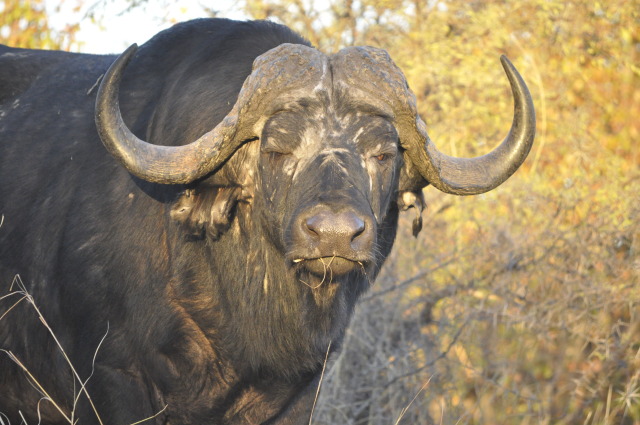The aim of the thread is for all mites to join in and to :
* Endeavour to find and mark-off as many species in your animal book as possible.
* To highlight their different behavior, diets, breeding.
* To chat about their habitats and migration.
* Dig up all your pics you have and share with us.
* Take your camera on a hunting trip.
The African buffalo is a very robust species. - and one of the Big Five
Its shoulder height can range from 1 to 1.7 m (3.3 to 5.6 ft)
and its head-and-body length can range from 1.7 to 3.4 m (5.6 to 11 ft).
Compared with other large bovids, it has a long but stocky body and short but thickset legs, resulting in a relatively short standing height.
The tail can range from 70 to 110 cm (28 to 43 in) long.
Savannah-type buffaloes weigh 500 to 910 kg (1,100 to 2,000 lb), with males normally larger than females, reaching the upper weight range. A record-sized savannah-type male weighed 1,000 kg (2,200 lb).
The horns of African buffalo are very peculiar. A characteristic feature of them is the adult bull's horns have fused bases, forming a continuous bone shield referred to as a "boss", which can not always be penetrated even by a rifle bullet. From the base, the horns diverge, then bend down, and then smoothly curve upwards and outwards. The distance between the ends of the horns of large bulls is more than a metre.
The young buffalo horn boss forms fully only upon reaching the age of five to six years.
In cows, the horns are, on average, 10-20% smaller, and the boss is less prominent.
The African buffalo is one of the most successful grazers in Africa.
It lives in swamps and floodplains, as well as mopane grasslands and forests of the major mountains of Africa.
This buffalo prefers habitat with dense cover, such as reeds and thickets, but can also been found in open woodland.
While not particularly demanding with regard to habitat, they require water daily, so depend on perennial sources of water. The buffalo can live on tall, coarse grasses. Herds of buffalo mow down grasses and make way for more selective grazers.
When feeding, the buffalo makes use of its tongue and wide incisor row to eat grass more quickly than most other African herbivores. Buffaloes do not stay on trampled or depleted areas for long.
info : Wikipedia
African Buffalo
- H. erectus
- Posts: 5841
- Joined: Fri Jun 01, 2012 6:43 pm
- Country: South Africa
- Contact:
Re: African Buffalo
Listed as Least Concern as the species remains widespread, with a global population estimated at nearly 900000 animals, of which more than three-quarters are in protected areas. While some populations (subspecies) are decreasing, others will remain unchanged in the long term if large, healthy populations continue to persist in a substantial number of national parks, equivalent reserves and hunting zones in southern and eastern Africa.
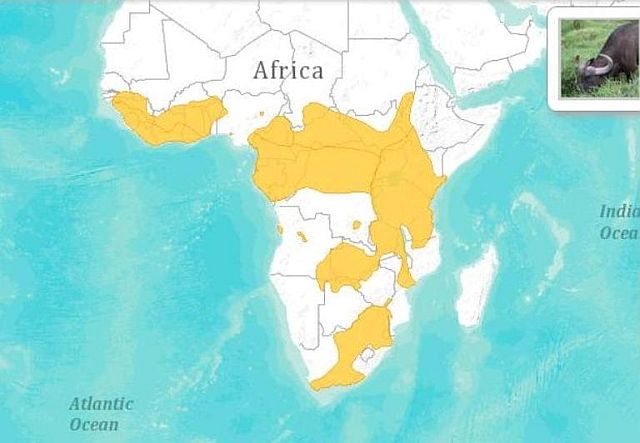
The species is distributed throughout sub-Saharan Africa, but is now generally confined to protected areas, within which it is well represented, and other areas which are sparsely settled. In South Africa, they have been reintroduced to areas from which they were formerly extirpated.
Source: IUCN Red List
 I would love to see here Buffalo from as many areas as possible.
I would love to see here Buffalo from as many areas as possible.
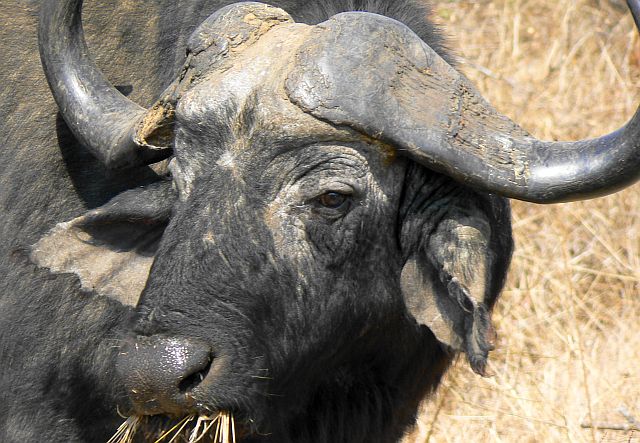 Kruger NP, Crocodile Bridge
Kruger NP, Crocodile Bridge
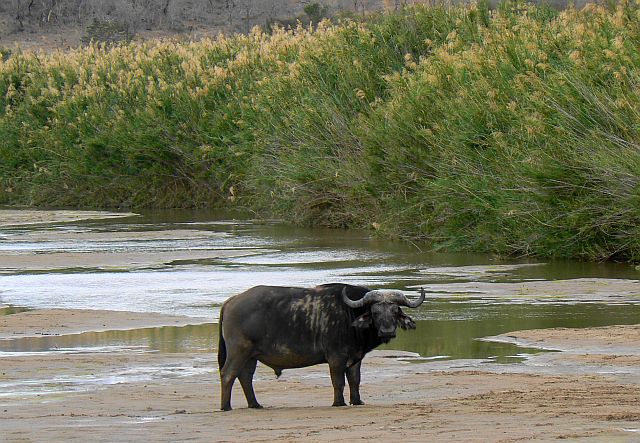 iMfolozi section of Hluhluwe-iMfolozi Park
iMfolozi section of Hluhluwe-iMfolozi Park
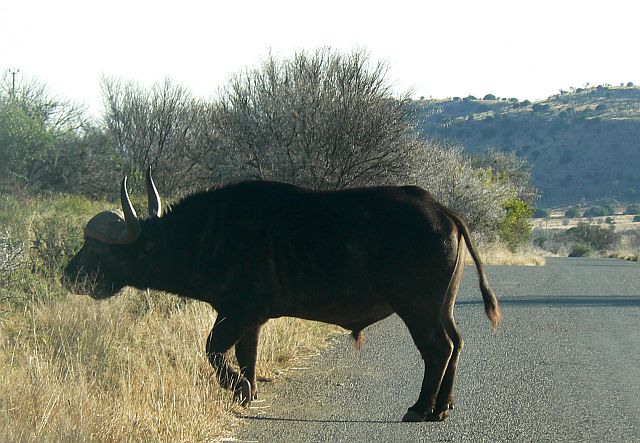 Mountain Zebra NP
Mountain Zebra NP
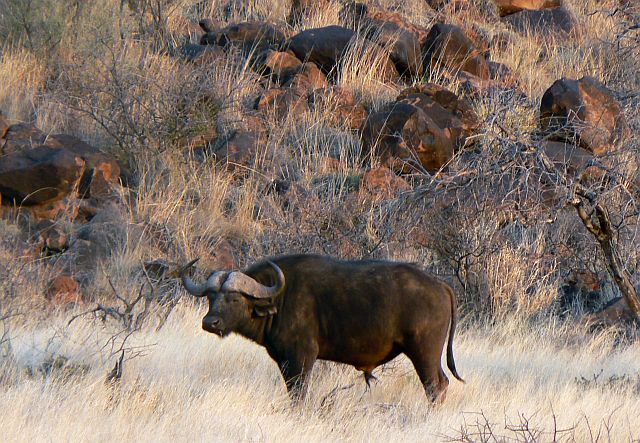 Mokala NP
Mokala NP

The species is distributed throughout sub-Saharan Africa, but is now generally confined to protected areas, within which it is well represented, and other areas which are sparsely settled. In South Africa, they have been reintroduced to areas from which they were formerly extirpated.
Source: IUCN Red List
 Kruger NP, Crocodile Bridge
Kruger NP, Crocodile Bridge iMfolozi section of Hluhluwe-iMfolozi Park
iMfolozi section of Hluhluwe-iMfolozi Park  Mountain Zebra NP
Mountain Zebra NP Mokala NP
Mokala NP- Amoli
- Posts: 6032
- Joined: Fri Jun 01, 2012 4:30 am
- Country: South Africa
- Location: Kempton Park
- Contact:
Re: African Buffalo
I believe it is the older buffalo that develop these white marks in theirs faces - also as per previous pics posted.

Who has ever listened to the noises these buffs make. I found the following interesting and will make sure I LISTEN in future...
Vocalizations
African buffaloes make various vocalizations.
Many calls are lower-pitched versions of those emitted by domestic cattle.
They emit low-pitched, two- to four-second calls intermittently at three- to six-second intervals to signal the herd to move.
To signal to the herd to change direction, leaders will emit "gritty", "creaking gate" sounds.
When moving to drinking places, some individuals make long maaa calls up to 20 times a minute.
When being aggressive, they make explosive grunts that may last long or turn into rumbling growl.
Cows produce croaking calls when looking for their calves.
Calves will make a similar call of a higher pitch when in distress.
When threatened by predators, they make drawn-out waaaa calls.
Dominant individuals make calls to announce their presence and location.
A more intense version of the same call is emitted as a warning to an encroaching inferior.
When grazing, they will make various sounds, such as brief bellows, grunts, honks and croaks.

Who has ever listened to the noises these buffs make. I found the following interesting and will make sure I LISTEN in future...
Vocalizations
African buffaloes make various vocalizations.
Many calls are lower-pitched versions of those emitted by domestic cattle.
They emit low-pitched, two- to four-second calls intermittently at three- to six-second intervals to signal the herd to move.
To signal to the herd to change direction, leaders will emit "gritty", "creaking gate" sounds.
When moving to drinking places, some individuals make long maaa calls up to 20 times a minute.
When being aggressive, they make explosive grunts that may last long or turn into rumbling growl.
Cows produce croaking calls when looking for their calves.
Calves will make a similar call of a higher pitch when in distress.
When threatened by predators, they make drawn-out waaaa calls.
Dominant individuals make calls to announce their presence and location.
A more intense version of the same call is emitted as a warning to an encroaching inferior.
When grazing, they will make various sounds, such as brief bellows, grunts, honks and croaks.
Pretoriuskop
Satara
Shingwedzi
20-30 Dec 2014
Satara
Shingwedzi
20-30 Dec 2014
- H. erectus
- Posts: 5841
- Joined: Fri Jun 01, 2012 6:43 pm
- Country: South Africa
- Contact:
Re: African Buffalo
The older buffs, usually have ears in tatters.???
One of Toko's pictures shows a beast with a horn
about to fall, as it seems in a advanced state of
deterioration.
One of Toko's pictures shows a beast with a horn
about to fall, as it seems in a advanced state of
deterioration.
Heh,.. H.e
- Richprins
- Committee Member
- Posts: 75451
- Joined: Sat May 19, 2012 3:52 pm
- Location: NELSPRUIT
- Contact:
Re: African Buffalo
The biggest Kruger herd was estimated at 1500, near Tshokwane in the 1980's!
An amalgamation of other herds for some reason!
An amalgamation of other herds for some reason!
Please check Needs Attention pre-booking: https://africawild-forum.com/viewtopic.php?f=322&t=596
- Richprins
- Committee Member
- Posts: 75451
- Joined: Sat May 19, 2012 3:52 pm
- Location: NELSPRUIT
- Contact:
Re: African Buffalo
Baobab Hill last year:
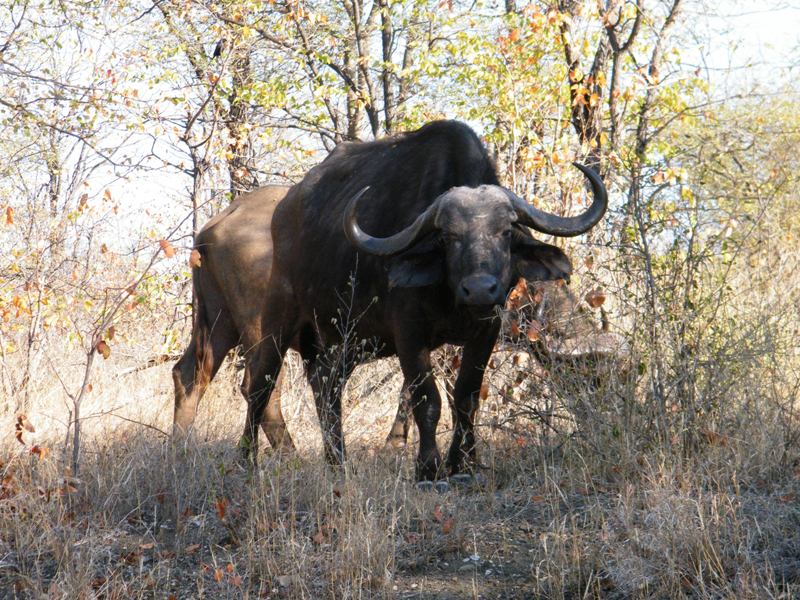

Please check Needs Attention pre-booking: https://africawild-forum.com/viewtopic.php?f=322&t=596
- Richprins
- Committee Member
- Posts: 75451
- Joined: Sat May 19, 2012 3:52 pm
- Location: NELSPRUIT
- Contact:
Re: African Buffalo
Also interesting is that there has only been one instance I know of where Buffalo have rammed a car...a cow with it's calf uniquely trapped on the other side of a ranger bakkie in a remote Northern location, away from tourist roads! 
No need to be afraid at all!
No need to be afraid at all!
Please check Needs Attention pre-booking: https://africawild-forum.com/viewtopic.php?f=322&t=596
- H. erectus
- Posts: 5841
- Joined: Fri Jun 01, 2012 6:43 pm
- Country: South Africa
- Contact:
Re: African Buffalo
A unique once in a life time experience, would be
to find oneself surrounded by a herd, 300 hundred
strong maybe, of these animals!
Indeed not to be afraid at all, however this beast is
known to be very aggressive when wounded!!!
Will never forget a story, news clip, of a hunter being
attacked by a wounded buff!! Apparently the buff rolled
the hunter to death!, after surprising him!!!
to find oneself surrounded by a herd, 300 hundred
strong maybe, of these animals!
Indeed not to be afraid at all, however this beast is
known to be very aggressive when wounded!!!
Will never forget a story, news clip, of a hunter being
attacked by a wounded buff!! Apparently the buff rolled
the hunter to death!, after surprising him!!!
Heh,.. H.e
- Amoli
- Posts: 6032
- Joined: Fri Jun 01, 2012 4:30 am
- Country: South Africa
- Location: Kempton Park
- Contact:
Re: African Buffalo
Very interesting reading material... 
HE - I did not notice the horn at first, and went back to look.
It must take some doing for it to deteriote to this stage when I read up on the strength of their horns.
What I also found as a wow, is that the width between their two horns could measure up to a metre.
RP - I would be scared if I was surrounded by two buffalo, nevermind 200 or 1500.... -O -O
I presume any animal must be dangerous when wounded - or at least stay clear.
HE - I did not notice the horn at first, and went back to look.
It must take some doing for it to deteriote to this stage when I read up on the strength of their horns.
What I also found as a wow, is that the width between their two horns could measure up to a metre.
RP - I would be scared if I was surrounded by two buffalo, nevermind 200 or 1500.... -O -O
I presume any animal must be dangerous when wounded - or at least stay clear.
Pretoriuskop
Satara
Shingwedzi
20-30 Dec 2014
Satara
Shingwedzi
20-30 Dec 2014



